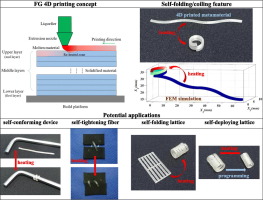当前位置:
X-MOL 学术
›
Mater. Des.
›
论文详情
Our official English website, www.x-mol.net, welcomes your
feedback! (Note: you will need to create a separate account there.)
Adaptive metamaterials by functionally graded 4D printing
Materials & Design ( IF 7.6 ) Pub Date : 2017-12-01 , DOI: 10.1016/j.matdes.2017.08.069 M. Bodaghi , A.R. Damanpack , W.H. Liao
Materials & Design ( IF 7.6 ) Pub Date : 2017-12-01 , DOI: 10.1016/j.matdes.2017.08.069 M. Bodaghi , A.R. Damanpack , W.H. Liao

|
Abstract This paper shows how fused decomposition modeling (FDM) as a three-dimensional (3D) printing technology can engineer adaptive metamaterials with performance-driven functionality built directly into materials. The tactic is based on an understanding of thermo-mechanics of shape memory polymers (SMP) and fabrication concept behind FDM as well as experiments to explore how FDM can program self-foldable metamaterials. Self-folding mechanism is investigated in terms of fabrication parameters like printing-speed and liquefier-temperature that affect layer-by-layer programming process and shape-change. It can be called a functionally graded 4D printing so that the structure is fabricated additively and programmed functionally. A finite element (FE) formulation based on the non-linear Green-Lagrange kinematic relations coupled with a robust SMP constitutive model is established to describe material tailoring in fabrication stage and deformation. Governing equations with material-geometric non-linearities are solved by implementing iterative Newton-Raphson method to trace large-deformation non-linear equilibrium path. FDM and FE solution are then applied to digitally design and fabricate straight/curved beams as structural primitives for adaptive metamaterials that show 1D/2D-to-2D/3D shape-shifting by self-folding or/and self-coiling. Finally, it is experimentally shown that the 4D printed metamaterials have great potential in mechanical/biomedical applications like structural/dynamical switches, self-conforming substrates, self-tightening surgical sutures, self-conforming splints and self-coiling/deploying stents.
中文翻译:

通过功能分级 4D 打印的自适应超材料
摘要 本文展示了融合分解建模 (FDM) 作为一种三维 (3D) 打印技术如何设计具有直接内置于材料中的性能驱动功能的自适应超材料。该策略基于对形状记忆聚合物 (SMP) 的热力学和 FDM 背后的制造概念的理解,以及探索 FDM 如何编程自折叠超材料的实验。根据影响逐层编程过程和形状变化的打印速度和液化器温度等制造参数研究自折叠机制。它可以称为功能分级的 4D 打印,因此结构是通过附加制造和功能编程的。建立了基于非线性格林-拉格朗日运动学关系和稳健 SMP 本构模型的有限元 (FE) 公式来描述制造阶段的材料剪裁和变形。通过实施迭代牛顿-拉夫森方法来追踪大变形非线性平衡路径,求解具有材料几何非线性的控制方程。然后将 FDM 和 FE 解决方案应用于数字设计和制造直/弯曲梁,作为自适应超材料的结构基元,通过自折叠或/和自卷曲显示 1D/2D 到 2D/3D 形状转换。最后,实验表明 4D 打印的超材料在机械/生物医学应用中具有巨大的潜力,如结构/动力开关、自顺应基底、自紧手术缝合线、
更新日期:2017-12-01
中文翻译:

通过功能分级 4D 打印的自适应超材料
摘要 本文展示了融合分解建模 (FDM) 作为一种三维 (3D) 打印技术如何设计具有直接内置于材料中的性能驱动功能的自适应超材料。该策略基于对形状记忆聚合物 (SMP) 的热力学和 FDM 背后的制造概念的理解,以及探索 FDM 如何编程自折叠超材料的实验。根据影响逐层编程过程和形状变化的打印速度和液化器温度等制造参数研究自折叠机制。它可以称为功能分级的 4D 打印,因此结构是通过附加制造和功能编程的。建立了基于非线性格林-拉格朗日运动学关系和稳健 SMP 本构模型的有限元 (FE) 公式来描述制造阶段的材料剪裁和变形。通过实施迭代牛顿-拉夫森方法来追踪大变形非线性平衡路径,求解具有材料几何非线性的控制方程。然后将 FDM 和 FE 解决方案应用于数字设计和制造直/弯曲梁,作为自适应超材料的结构基元,通过自折叠或/和自卷曲显示 1D/2D 到 2D/3D 形状转换。最后,实验表明 4D 打印的超材料在机械/生物医学应用中具有巨大的潜力,如结构/动力开关、自顺应基底、自紧手术缝合线、











































 京公网安备 11010802027423号
京公网安备 11010802027423号